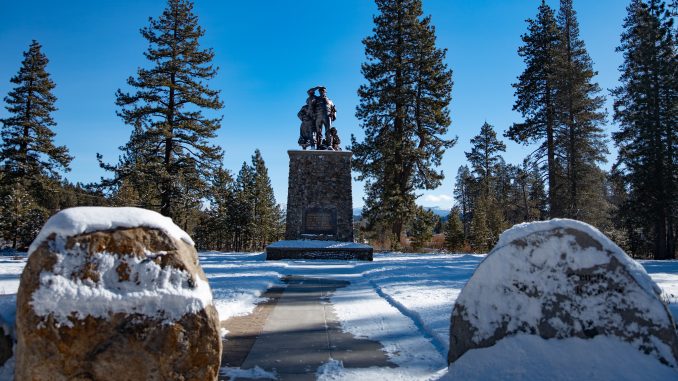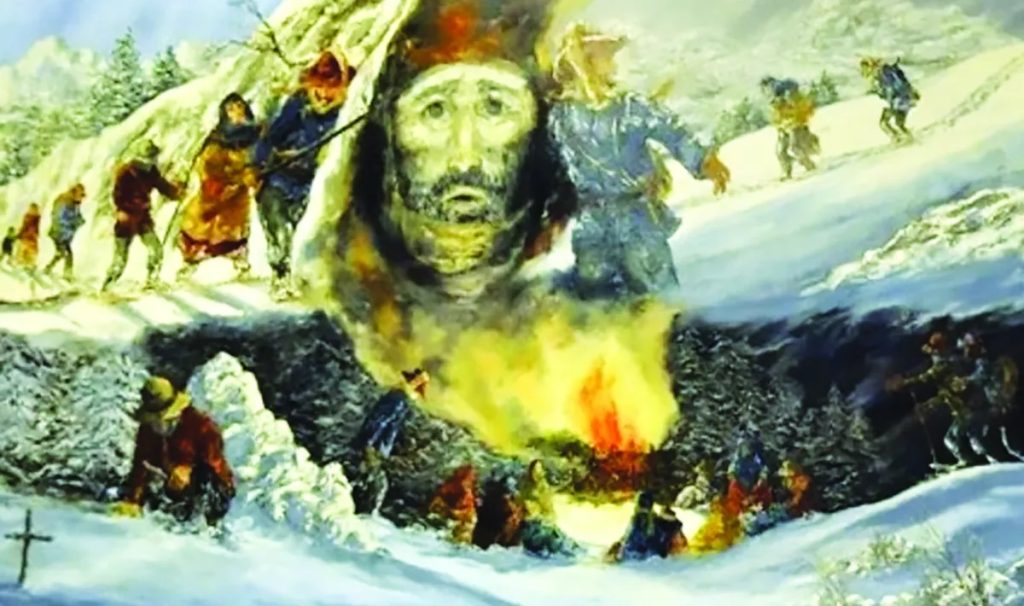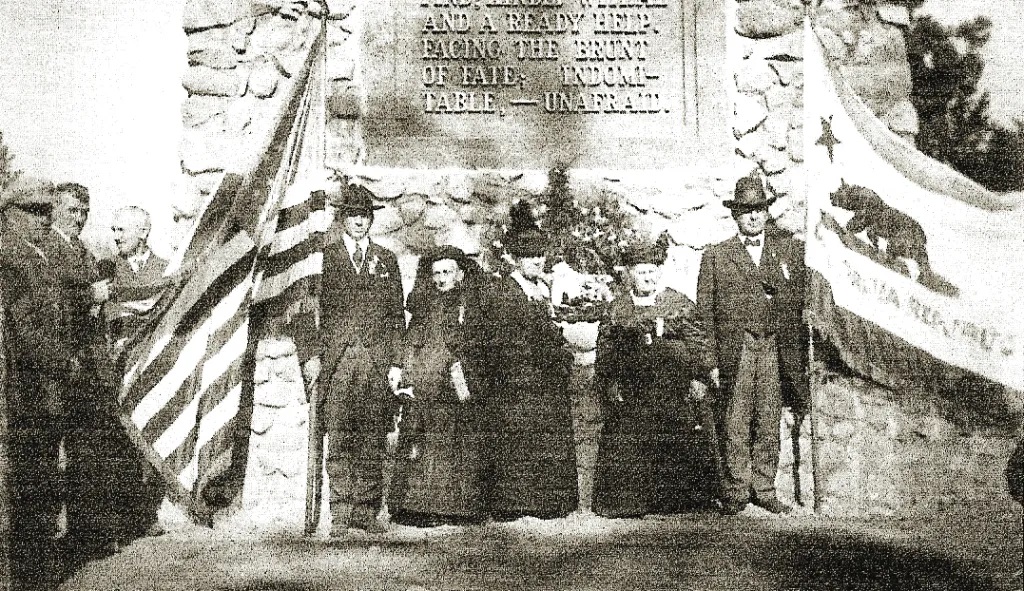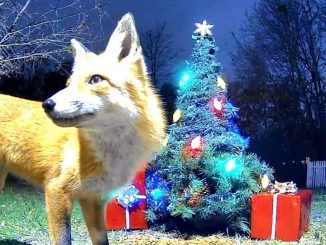
This story was originally published in the Reno News & Review.
Karl Ahlrichs, a descendant of George Donner, connected with his family’s history at age 11, when he read a book about the Donner Party’s 2,000-mile walk across the continent and entrapment in the Sierra Nevada during the terrible winter of 1846-47.
“As a kid, the Donner story was a part of family folklore, but it wasn’t until I read Ordeal by Hunger (by George R. Stewart) that I found out the details,” said Ahlrichs, who lives in Indianapolis. “I was gripped by it. It was about kids my age, crossing the plains and deserts, and getting trapped on a mountaintop. I saw it as an adventure story. There was double excitement, because they were my ancestors.”
Aldrich’s fascination with the doomed emigrants continued into adulthood. He read more books, dug into historical research and visited the pioneers’ campsites at and near Donner Lake, 36 miles west of Reno. When he was a boy, his thoughts often returned to the plight of those pioneers on Christmas, when the starving families huddled in makeshift shelters as a series of storms hammered the Sierra Nevada.
“Our family had German-Lutheran traditions and rituals on the holiday; we’d light candles and read the accounts of Christ’s birth in the Bible,” he said. “We were comfortable, cared for and well-fed. I understood how fortunate I was compared with what the Donner families had gone through.”
Amid the suffering, there was a ray of hope: One of the mothers had squirreled away morsels of food to provide her four children with a “feast” on Christmas Day.
“That’s a very powerful part of the story,” Ahlrichs said. “It stuck with me when I read it. I could feel the excitement of the children as they watched the pot boil and realized that they would be eating real food again. The contrast of that simple thing bringing them joy and what they had suffered through really resonates.
“It makes me think how fortunate we are, and how people can find hope in what seems a hopeless situation. … It’s not your usual Christmas story.”
A false ‘shortcut’
The Donner Party’s journey began with laughter and hope in the spring of 1846.
The two Donner families and the Reed family, the nucleus of the Donner Party, crossed the Missouri River in May 1846 and aimed their nine covered wagons west, toward the promised land of California. They expected a five-month, 2,000-mile walk across the continent—but they took an unproven shortcut through what is now Utah and Nevada that added 150 miles and weeks of travel.
The vanguard of the party arrived at the future site of Reno during the last week of October to see snow blanketing the Sierra, and arrived at what is now Donner Lake on Oct. 31. The emigrants several times attempted to cross the high pass, but couldn’t make headway through the deep snow. The 81 members of the party, including 41 children, were entrapped in the Sierra. A series of storms pinned them in place for months.
Their remaining oxen were buried, standing, in the snow. They probed the drifts, but the deceased cattle were lost until spring. They had already scraped the bottoms of barrels and soon ate their dogs, cracked the bones of previous meals to suck out the marrow, and boiled leather for hours to make a gluey broth that was nearly impossible to swallow. Famine stalked the camps.
Most of the pioneers stayed in three makeshift cabins near Donner Lake at an altitude of 5,936 feet above sea level. The George and Jacob Donner families, delayed by a wagon accident, were crowded in tents and lean-tos 6 miles east of the lake, at Alder Creek camp.
The ‘Forlorn Hope’
On Dec. 16, five women and 10 men on snowshoes left the high camps in an attempt to reach the American settlements they thought were 40 miles to the west. By Christmas Eve, eight days later, the 15 snowshoers, later dubbed the “Forlorn Hope,” had faced one calamity after another.
Their guide, Charles Stanton, 35, went snow blind and was left behind on Dec. 21. Two days later, another storm caught the group in the open. The freezing escape party hurriedly made camp. On Christmas Eve, the surviving members of the Forlorn Hope drew lots to determine who would be killed to provide meat for the others. No one had the heart to carry out the death sentence on the loser. That night, Antonio, a 23-year-old Mexican herder, was dying. Patrick Dolan, 35, had gone mad as a result of hyperthermia. He shed his clothes and cavorted in the snow, claiming to be too warm. Franklin Ward Graves, 57, who made the snowshoes back at the lake, was frostbitten, starving and failing.

By Christmas morning, Antonio, Dolan and Graves were dead. With his last breath, Franklin Graves had begged his daughters, Mary and Sarah, to use his flesh for nourishment. The place where they were stranded was later dubbed the “Camp of Death.”
Two days after that Christmas, the cannibalism that has come to define the Donner Party began at the starved camp. They ate the forbidden food. They wept. Around the campfire, no one could meet the eyes of another.
What was left of the snowshoe party resumed its march westward when the storms abated. The group became lost in the maze of canyons along the North Fork of the American River. More of them died before reaching the California settlements weeks later.
Back at the lake
That Christmas, as the escape party huddled around a fire that was sinking in the deep snow, their companions at the lake also suffered.
In the Breen cabin, whose site now is beneath the Pioneer Monument at Donner Memorial State Park, Patrick and Margaret Breen and their seven children spent the holiday in misery.
“Rained all night and still continues to rain,” Patrick Breen, 51, wrote in his diary on Christmas Eve. He estimated the snow to be about 7 feet deep. “Poor prospect for any kind of comfort,” he wrote. “… May God help us to spend the Christmas as we ought considering circumstances.”
More snow arrived around noon on Dec. 24 and fell throughout Christmas Day, according to Breen, who was suffering from kidney stones and could barely rise from the moldy quilts on the cabin floor.
His older sons left the cabin to collect firewood. On Dec. 25, Breen wrote: “Offered our prayers to God this Christmas morning.” The future looked bleak: “The prospect is appalling but (we) hope in God Amen,” he wrote.
The others left behind in the high camps also suffered, prayed and waited. Several in the high camps had already died. The rest were emaciated and weak. Snow hugged the pine branches and covered the entrances to their shelters. “No living thing without wings can get about,” Breen wrote.
About 100 yards from Breens’ shanty, the cabin of the Murphy family was built around a boulder left on the mountain thousands of years before by a creeping glacier. Their family’s hearth was against the large rock, which served as one of the cabin’s four walls. The Murphys had a fire, but little else.
“Christmas we had a meal of boiled bones and oxtail soup,” recalled Mary Murphy, who was 14 at the time of the ordeal. “After supper mother was barely able to put the babies to bed, and later on that evening, with brother William reading her favorite psalm from the Good Book, she became bedridden and seriously ill.”
Six miles west of the lake at Alder Creek, the two Donner families and several others didn’t have time to build cabins before the storms began their march—and they were in even worse shape than their comrades at the lake. The six men, three women and 12 children at Alder Creek had been living on thin soup, made from animal bones boiled over and over. They also choked down the glue that formed on iron pots after they boiled strips of leather. The few people who could still move about occasionally ventured outside their tents to brush accumulating snow off the canvas so that the flimsy shelters weren’t crushed.
George Donner, the party’s leader, was suffering from gangrene. His brother, Jacob, overcome with despair, had died wrapped in blankets. The Donner children—including Frances, 6; Eliza, 3; and Georgia, 4—were swaddled in damp wool blankets and covered in quilts or stinking buffalo robes. They barely stirred.
At Alder Creek, the holiday passed as any other day of misery.
A surprise ‘feast’
But in the Reed family’s half of the Graves cabin, whose site is now beneath Interstate 80, Christmas was marked with an unexpected celebration. Margaret Reed, 32—whose husband, James, 45, had been banished from the group in October—had planned a surprise for her four children.
“My mother had determined weeks before that her children should have a treat on this one day,” survivor Virginia Reed, then 13, remembered later. “She had laid away a few dried apples, some beans, a bit of tripe and a small piece of bacon.”

On Christmas morning, Virginia; Patty, 9; and their brothers, James Jr., 5; and Thomas, 3, had ox hide “soup” for breakfast. The brown water hardly dented their hunger.
“Christmas Eve came, no stockings to hang, no Santa Claus to come down our chimney in that cold starving camp. No Papa to come home to his children,” Patty Reid later wrote. “Christmas morning came and our breakfast was a pot of glue, it was stewed ox hide, but we were pleased to have even that to eat. But as soon as we had gone through this … our mother’s face began to brighten … she had a surprise awaiting us.”
Virginia remembered that “the delight of the little ones knew no bounds. The cooking was watched carefully.” To the children’s eyes, the scraps of food looked as appetizing as a sumptuous meal in a fine restaurant. “It was simply grand!” Patty wrote. The Reeds shared the banquet with the Graves family.
The children’s faces were illuminated by the flickering light of a blazing pine stick as the blizzard howled outside the tiny cabin. The wind whistled through gaps in the log walls. The roof, covered in animal hides, dripped near-freezing water on their heads. But no matter: There was hot food in the kettle. It was a Christmas to remember.
“Children, eat slowly,” Margaret Reed told them, “for this one day you can have all you wish.”
After midnight, the storm abated, and the sky cleared to reveal a crescent moon whose rays glittered like gems atop a blanket of snow that Patrick Breen estimated to be more than 7 feet deep. The snow level at the pass was estimated to be double that depth.
This year, 2022, Donner Pass accumulated more than three feet of snow by Nov. 18, according to the Central Sierra Snow Laboratory. The pass averages about 34 feet of snowfall annually. But the visitor’s center at Donner Lake remains open in winter.
“We do get heavy visitation on winter weekends,” said Jeremy Lin, a park interpreter at Donner Memorial State Park. “We’re open every day and have become kind of a little hub, because we’re open and functioning in snowstorms when other businesses are closed down because of the weather.”
In December, the park offers snowshoe tours on a loop trail which includes the Murphy cabin site at the big rock. “We also go into the campground a bit, where we have the fresh, untrammeled snow. It’s real light and fluffy; it gives people the feeling of what it was like 176 years ago,” Lin said.
Snowshoers can trek through the Jeffrey pines and quaking aspens and feel the cold nipping at their ears and noses.
“Once you get away from the Visitors’ Center, and you are out in the forest, it’s easy to envision what they faced in the wilderness,” Lin said. “Three minutes out on the loop trail is a landscape of trees and snow and streams. You can kind of picture yourself back in 1847, when this land was wilderness.”
He also tells the story of Christmas at the camps, a tale that evokes visitors’ emotions.
“People have a very visceral reaction to the story,” he said. “It brings the starvation down to a particular moment and a single family. It punctuates how terrible the conditions were. When children were excited to have those meager scraps as a treat, you realize how desperate things were here. … Everyone today overeats on holidays, but knowing what they went through makes us more grateful for what we have now.”
On Jan. 18, 1847, the seven survivors of the Forlorn Hope group reached the California settlements. The first rescue party made it to the high camps in late February. The last survivor was taken off the mountain in mid-April. In those final weeks of the ordeal, some of the survivors at the high camps also choose cannibalism as a desperate, last resort.
Of the 81 souls trapped in the mountains, 36 died, and 45 survived. Most of the men died; most of the women and school-age children lived. For those who survived, the long ordeal—and that Christmas Day—was never far from their minds.
“So bitter was the misery relieved this one bright day, that I have never since sat down to a Christmas dinner without my thoughts going back to Donner Lake,” Virginia Reed wrote in Across the Plains With the Donner Party, a memoir penned 30 years later.
Said Ahlrichs, George Donner’s descendant: “Going through that ordeal changed those kids’ lives forever. They carried that experience with them for the rest of their days.”
The Pioneer Monument was dedicated in 1918, with Patty Reed, and sisters Frances Donner Wilder and Eliza Donner Houghton as honored guests. Photos of the ceremony show the elderly trio in front of the statue’s 22-foot high stone pedestal, a height thought to be the maximum depth of snow at the lake that winter.
The women are dressed in black, flanked by the governors of California and Nevada, but there’s a detail that the camera could not show: Frances Donner Wilder, 78, who was 6 at the time of the entrapment, had crackers and peppermint candies in her dress pocket. She always kept such morsels on her person since reaching safety at Sutter’s Fort in 1847.
Frances was determined that for the rest of her life, she would never go hungry again.



Be the first to comment